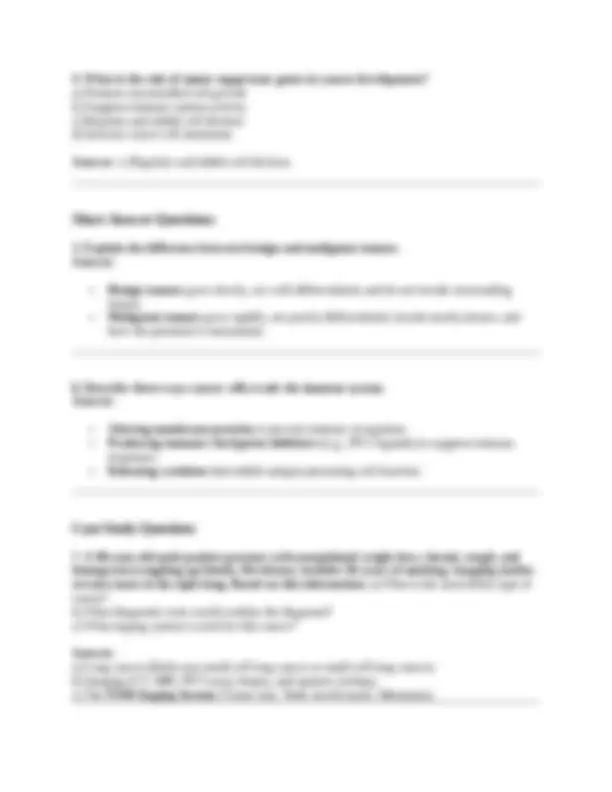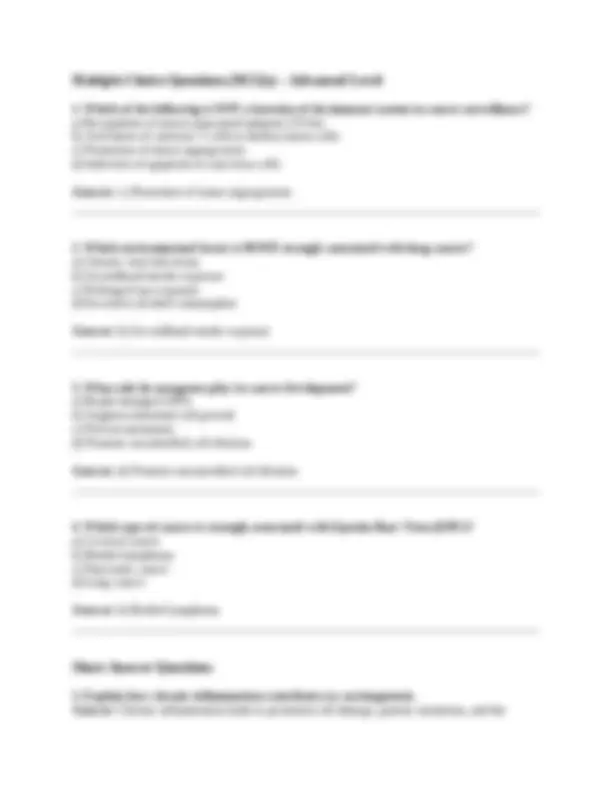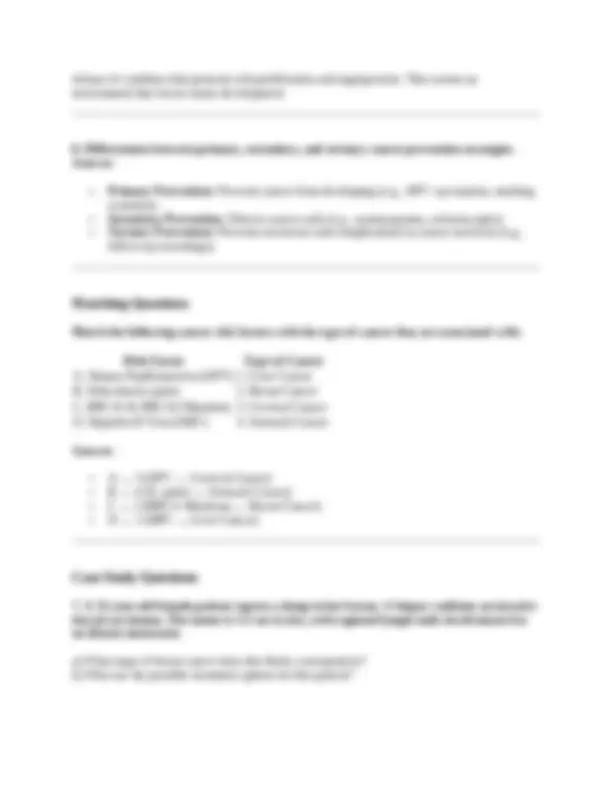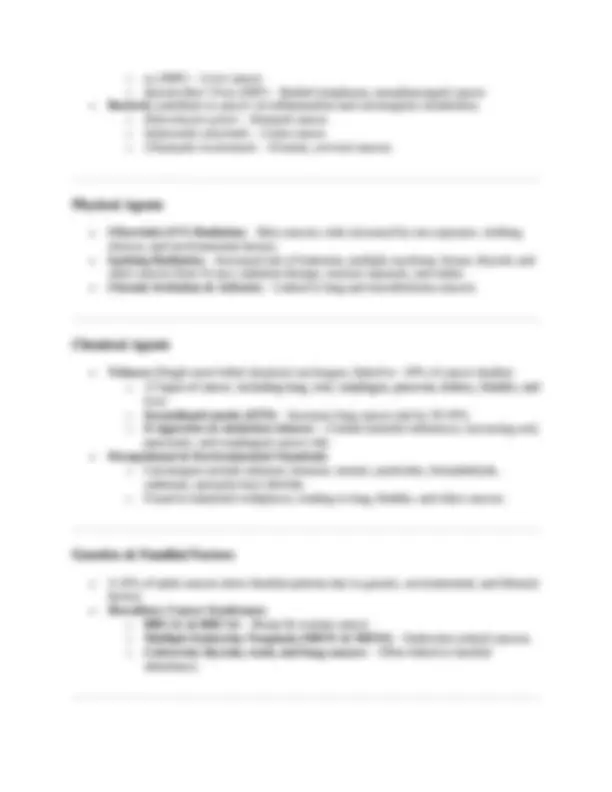







Study with the several resources on Docsity

Earn points by helping other students or get them with a premium plan


Prepare for your exams
Study with the several resources on Docsity

Earn points to download
Earn points by helping other students or get them with a premium plan
Community
Ask the community for help and clear up your study doubts
Discover the best universities in your country according to Docsity users
Free resources
Download our free guides on studying techniques, anxiety management strategies, and thesis advice from Docsity tutors
study note for exam course NSG 223 year 2025
Typology: Study notes
1 / 9

This page cannot be seen from the preview
Don't miss anything!






Chemotherapy Study Exam Section 1: Multiple Choice Questions (MCQs)
1. What is the primary cause of cancer development? a) Bacterial infections b) Genetic mutations in cellular DNA c) Fungal overgrowth d) Hormone replacement therapy Answer: b) Genetic mutations in cellular DNA 2. Which of the following cancers is most common in men? a) Breast cancer b) Ovarian cancer c) Prostate cancer d) Endometrial cancer Answer: c) Prostate cancer 3. The process of carcinogenesis occurs in three stages. Which is the correct sequence? a) Promotion, Initiation, Progression b) Initiation, Promotion, Progression c) Progression, Initiation, Promotion d) Initiation, Progression, Promotion Answer: b) Initiation, Promotion, Progression
1. Which of the following is NOT a function of the immune system in cancer surveillance? a) Recognition of tumor-associated antigens (TAAs) b) Activation of cytotoxic T cells to destroy tumor cells c) Promotion of tumor angiogenesis d) Induction of apoptosis in cancerous cells Answer: c) Promotion of tumor angiogenesis 2. Which environmental factor is MOST strongly associated with lung cancer? a) Chronic viral infections b) Secondhand smoke exposure c) Prolonged sun exposure d) Excessive alcohol consumption Answer: b) Secondhand smoke exposure 3. What role do oncogenes play in cancer development? a) Repair damaged DNA b) Suppress abnormal cell growth c) Prevent metastasis d) Promote uncontrolled cell division Answer: d) Promote uncontrolled cell division 4. Which type of cancer is strongly associated with Epstein-Barr Virus (EBV)? a) Cervical cancer b) Burkitt lymphoma c) Pancreatic cancer d) Lung cancer Answer: b) Burkitt lymphoma
5. Explain how chronic inflammation contributes to carcinogenesis. Answer: Chronic inflammation leads to persistent cell damage, genetic mutations, and the
release of cytokines that promote cell proliferation and angiogenesis. This creates an environment that favors tumor development.
6. Differentiate between primary, secondary, and tertiary cancer prevention strategies. Answer: Primary Prevention: Prevents cancer from developing (e.g., HPV vaccination, smoking cessation). Secondary Prevention: Detects cancer early (e.g., mammograms, colonoscopies). Tertiary Prevention: Prevents recurrence and complications in cancer survivors (e.g., follow-up screenings).
Match the following cancer risk factors with the type of cancer they are associated with: Risk Factor Type of Cancer A. Human Papillomavirus (HPV) 1. Liver Cancer B. Helicobacter pylori 2. Breast Cancer C. BRCA1 & BRCA2 Mutations 3. Cervical Cancer D. Hepatitis B Virus (HBV) 4. Stomach Cancer Answer: A → 3 (HPV → Cervical Cancer) B → 4 (H. pylori → Stomach Cancer) C → 2 (BRCA Mutations → Breast Cancer) D → 1 (HBV → Liver Cancer)
7. A 52-year-old female patient reports a lump in her breast. A biopsy confirms an invasive ductal carcinoma. The tumor is 3.5 cm in size, with regional lymph node involvement but no distant metastasis. a) What stage of breast cancer does this likely correspond to? b) What are the possible treatment options for this patient?
A 67-year-old male presents with urinary hesitancy, weak urine stream, and nocturia. His PSA (Prostate-Specific Antigen) level is elevated at 12 ng/mL. A digital rectal exam reveals a firm, irregular prostate nodule. A biopsy confirms adenocarcinoma of the prostate. Questions: a) What are the risk factors for prostate cancer? b) What is the significance of the PSA level in prostate cancer diagnosis? c) What are the treatment options for localized versus metastatic prostate cancer? d) How would you counsel the patient on potential side effects of prostate cancer treatments, such as surgery and radiation?
A 45-year-old female presents with fatigue, frequent infections, and easy bruising over the past month. Blood work reveals severe anemia, thrombocytopenia, and elevated white blood cell count with blasts. A bone marrow biopsy confirms acute myeloid leukemia (AML). Questions: a) What are the hallmark signs and symptoms of AML? b) What laboratory findings are characteristic of AML? c) What are the treatment options for AML, and what are the potential complications? d) How would you explain the importance of infection prevention in patients undergoing chemotherapy for AML?
A 60-year-old woman presents with bloating, early satiety, and pelvic discomfort for the past few months. A pelvic ultrasound shows a complex ovarian mass, and CA-125 levels are elevated. Further imaging reveals peritoneal involvement. Questions: a) What are the common risk factors for ovarian cancer? b) Why is ovarian cancer often diagnosed at an advanced stage? c) What treatment modalities are used for ovarian cancer? d) How would you educate the patient on the signs and symptoms of ovarian cancer for early detection?
A 58-year-old male with a 30-year history of smoking presents with a chronic cough, hemoptysis, and unexplained weight loss. Imaging reveals a mass in the right lung, and biopsy confirms small-cell lung cancer (SCLC). Further evaluation shows brain metastases. Questions: a) What is the typical progression and prognosis of small-cell lung cancer? b) What symptoms might indicate brain metastasis in lung cancer patients? c) What treatment options are available for SCLC with brain metastases? d) How would you address the patient’s concerns about palliative care and symptom management? Answer: Oncology nursing encompasses a wide range of specialties and age groups, addressing various aspects of cancer care from prevention to end-of-life management. Cancer, a complex group of disorders, arises from genetic mutations that lead to uncontrolled cell proliferation and can metastasize via lymphatic and vascular systems. Epidemiologically, cancer affects millions globally, with significant disparities influenced by socioeconomic factors and geographic variations. The immune system plays a critical role in identifying and eliminating cancer cells through immune surveillance mechanisms, although cancer cells can evade detection through various mechanisms, including immune checkpoint inhibitors. Understanding these foundational aspects equips oncology nurses to provide comprehensive care, including early detection through screening programs, patient education, and support across the cancer continuum. You said: